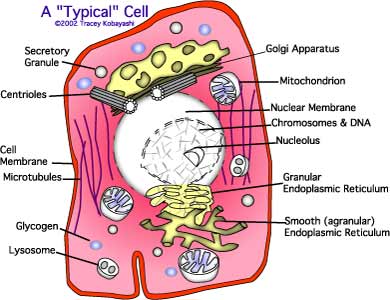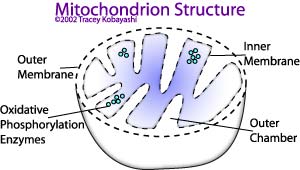
GE 345: Week 1
IV. Cell Innards
Updated by Tracey 8 July 02
Overview | Gross Cell | Cell Structure | Cell Innards | Synthesis
Each cell contains all of the parts necessary to keep functioning on its own. It interacts with the surrounding fluids from which it obtains nutrients and to which it sends waste products.
Main Cell Constituents
Remember, protoplasm is everything the cell is made of.
- Cytoplasm: fluid compartment between the cell & nuclear membranes. Contains organelles as well particles dispersed in cytosol, a clear fluid, including neutral fat globules, glycogen granules, ribosomes, secretory granules, organelles. Also contains dissolved proteins, electrolytes, phospholipids, cholesterol and esterified fatty acids.
-
Nucleus: the cell's control center. Regulates the cells reactions
and reproductive functions. Contains deoxyribonucleic acid (DNA), which
determines characteristics of the cell's protein structures and enzymes.
The Nucleus is closely associated with the Endoplasmic Reticulum:
- Outer layer of membrane continuous with ER
- Space between membrane layers continuous with compartment inside ER

The Organelles
Each organelle is a highly organized structure which contributes to the function of the cell.
- Endoplasmic Reticulum: Interconnected tubules and vesicles which
conducts substances throughout the cell and provides the machinery for most
of the cell's functions.
- Agranular ER: portion of ER with attached ribosomes, which function in protein synthesis. Forms glycoproteins, which are proteins conjugated with a carbohydrate.
- Agranular (Smooth) ER: no attached ribosomes. Synthesizes lipids, mostly in the form of phospholipids and cholesterol, which are incorporated into the ER's membrane. Transport vesicles, which break off the ER, prevent it from growing too large.
- Golgi Apparatus: closely related to ER, with membranes similar to the Agranular ER. Composed layers of thin, flat vesicles near the nucleus. Prominent in secretory cells, where it is located on the side of the cell where secretory substances are extruded. Also works in association with ER in that "transport vesicles" pinch off the ER and fuse with the Golgi Apparatus where they are processed to form lysosomes, secretory vesicles or other cellular components.
- Lysosomes: intracellular digestive system that digests intracellular substances, including damaged cell structures and bacteria. Filled with small granules which are protein aggregates of digestive enzymes. Digested proteins form amino acids. Digested carbohydrates form glucose.
- Mitochondria:
Help extract entergy from nutrients and oxygen.
Self-replicative -- can form new mitochondria based on need. Contains enzymes
which oxidate nutrients to create
adenosine triphosphate (ATP), which is transported from the mitochondrion
to wherever it is needed as energy for cellular metabolic reactions.

- Microtubules: Transport substances around the cell. Forms structures such as cilia.
Overview | Gross Cell | Cell Structure | Cell Innards | Synthesis